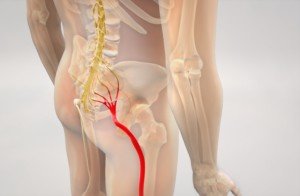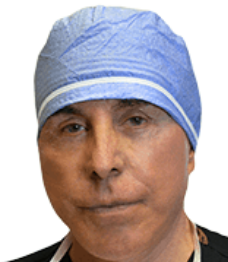
You’ve been noticing some twitching going on in your butt and/or leg muscles, and are hoping it’s due to your sciatica rather than ALS.
Muscle fasciculations can be caused by ALS, and “fasciculation” refers to twitching.
This makes many people terrified that a new-onset twitching — whether it’s very focal or widespread — might be the beginnings of ALS.
Can Sciatica Cause Muscles to Twitch?
“Yes; a muscle twitch is an indication of the pressure of the nerve, which means the nerve is under compression,” says Alfred O. Bonati, MD, owner of The Bonati Institute, a world leader in advanced spine surgery, Hudson, FL.
“This pressure on the nerves can be corrected by opening the canals to decompress the site that is pressing the nerve,” continues Dr. Bonati.
In sciatica, the sciatic nerve, which branches out from the spinal cord, is compressed or “pinched” by a vertebral disc.

Sciatica. Shutterstock/Nathan Devery
This compression classically causes shooting pain down the leg, sometimes starting at the buttocks level. It can be sudden and quite severe, even stabbing or piercing.
Numbness and tingling may also be associated with sciatica.
Typically, sciatica affects one side of the body. The pain has also been described as as burning.
When a patient is having these kinds of symptoms, a little muscle twitching in the same vicinity might not even be noticed.
“The other thing is if a patient has a twitch or nerve affected in different areas, that can be associated with a neurological disease,” says Dr. Bonati.
“So, the patient will need to be evaluated for a neurological illness.”
Muscle twitching is normally a benign condition and affects just about everyone sooner or later, and for some people it’s very frequent, including daily.
A person could by chance have both sciatica and benign muscle twitching located well-beyond the area that’s being affected by the sciatica.
An individual can have both sciatic symptoms and benign fasciculation syndrome: persistant muscle twitching that’s often accompanied by cramping of the muscles.
These are separate conditions, though; one does not cause the other.
The leading causes of twitching muscles are exercise, physical activity, fatigue, stress, anxiety and mineral imbalance.
The big red flag is if the twitching is accompanied by weakness in the associated muscle, visible atrophy in that muscle, or the presence of uncontrolled tremoring or shaking (the latter is not the same as fasciculations).
There is also something you need to be aware of: the phenomenon of perceived weakness.
You want to be sure that you do not get caught up in the entanglement of perceived weakness.
 Dr. Bonati, is a board certified orthopedic surgeon and was the first to develop and patent methods and instruments for laser assisted spine surgery – The Bonati Spine Procedures – for cervical, thoracic and lumbar spine problems.
Dr. Bonati, is a board certified orthopedic surgeon and was the first to develop and patent methods and instruments for laser assisted spine surgery – The Bonati Spine Procedures – for cervical, thoracic and lumbar spine problems.
 Lorra Garrick has been covering medical, fitness and cybersecurity topics for many years, having written thousands of articles for print magazines and websites, including as a ghostwriter. She is also a former ACE-certified personal trainer.
Lorra Garrick has been covering medical, fitness and cybersecurity topics for many years, having written thousands of articles for print magazines and websites, including as a ghostwriter. She is also a former ACE-certified personal trainer.


























